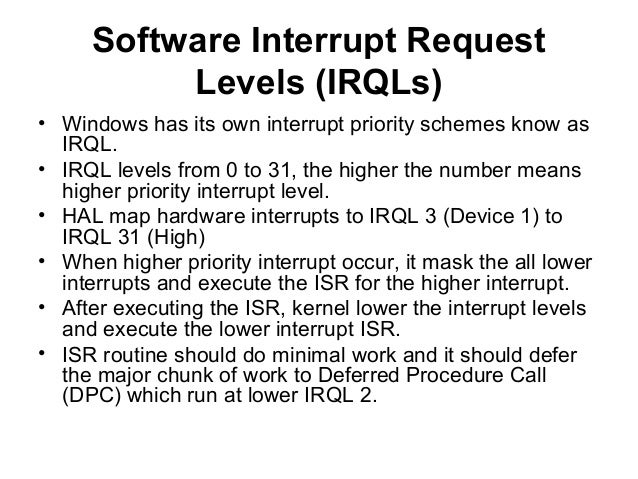System Interrupts Deferred Procedure Calls And Interrupt Service Routines
Difference between ISR and Function Call? (Interrupt Service Routine) and Function call. I feel both the function call and ISR are the same from the hardware perspective. Please Correct me if I am wrong. All I could found about ISR and Function call is as follows. A function (or procedure or sub-routine more generally) must be. Jan 31, 2019 - Tried-and-true solutions to fix System Interrupts High CPU Usage on Windows 10. Please click to read along to fix the error on your Windows.
A Deferred Procedure Call (DPC) is a Microsoft Windows operating system mechanism which allows high-priority tasks (e.g. an interrupt handler) to defer required but lower-priority tasks for later execution. This permits device drivers and other low-level event consumers to perform the high-priority part of their processing quickly, and schedule non-critical additional processing for execution at a lower priority.
DPCs are implemented by DPC objects which are created and initialized by the kernel when a device driver or some other kernel mode program issues requests for DPC. The DPC request is then added to the end of a DPC queue. Each processor has a separate DPC queue. DPCs have three priority levels: low, medium and high. By default, all DPCs are set to medium priority. When Windows drops to an IRQL of Dispatch/DPC level, it checks the DPC queue for any pending DPCs and executes them until the queue is empty or some other interrupt with a higher IRQL occurs.
For example, when the clock interrupt is generated, the clock interrupt handler generally increments the counter of the current thread to calculate the total execution time of that thread, and decrements its quantum time remaining by 1. When the counter drops to zero, the thread scheduler has to be invoked to choose the next thread to be executed on that processor and dispatcher to perform a context switch. Since the clock interrupt occurs at a much higher IRQL, it will be desirable to perform this thread dispatching which is a less critical task at a later time when the processor's IRQL drops. So the clock interrupt handler requests a DPC object and adds it to the end of the DPC queue which will process the dispatching when the processor's IRQL drops to DPC/Dispatch level.
When working with streaming audio or video that uses interrupts, DPCs are used to process the audio in each buffer as they stream in. If another DPC (from a poorly written driver) takes too long and another interrupt generates a new buffer of data, before the first one can be processed, a drop-out results.[1]

References[edit]
- General
- Art Baker & Jerry Lozano. (2000). Windows 2000 Device Driver Book: A Guide for Programmers, Second Edition, The. Prentice Hall. ISBN978-0-13-020431-8.
- Specific
- ^Ute Eberhardt (27 June 2012). 'DPC Latency Checker'. Thesycon.de. Retrieved 14 October 2017.
A driver of a physical device that receives interrupts registers one or more interrupt service routines (ISR) to service the interrupts. The system calls the ISR each time it receives that interrupt.
Devices for ports and buses prior to PCI 2.2 generate line-based interrupts. A device generates the interrupt by sending an electrical signal on a dedicated pin known as an interrupt line. Versions of Microsoft Windows prior to Windows Vista only support line-based interrupts.
Beginning with PCI 2.2, PCI devices can generate message-signaled interrupts. A device generates a message-signaled interrupt by writing a data value to a particular address. Windows Vista and later operating systems support both line-based and message-signaled interrupts.
The system supports two different types of ISRs:
System Interrupts High Cpu Reddit
The driver can register an InterruptService routine to handle line-based or message-signaled interrupts. (This is the only type available prior to Windows Vista.) The system passes a driver-supplied context value.
The driver can register an InterruptMessageService routine to handle message-signaled interrupts. The system passes both a driver-supplied context value and the message ID of the interrupt message.
Dpc Latency Checker
For more information about registering an InterruptService or InterruptMessageService routine to service the device's interrupts, see Introduction to Message-Signaled Interrupts.